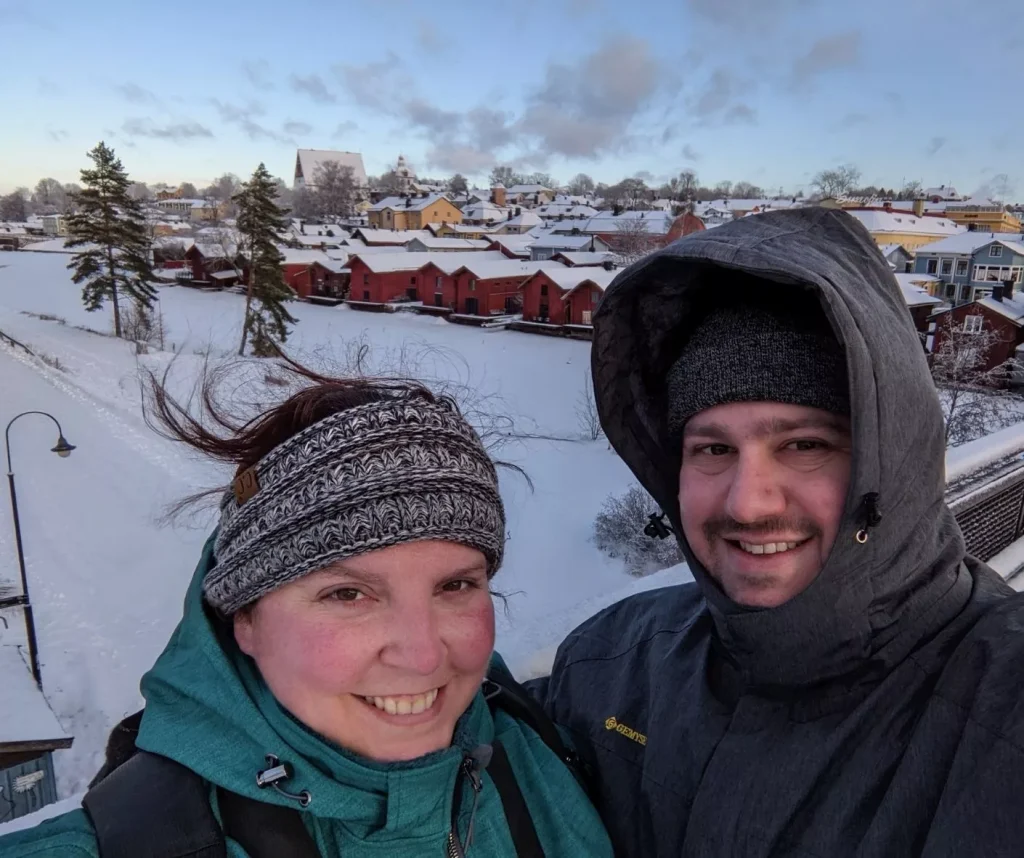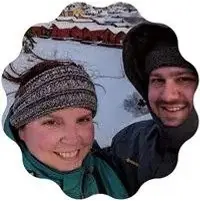How to Overcome Language Barriers when Traveling: 13 Tips for Success
Language Tips, Travel Tips / March 11, 2025 / 5 comments
One common challenge while traveling to a foreign country is the presence of unfamiliar languages, leading to difficulty in understanding and potential stress. Fearing how to overcome language barriers can deter people from traveling at all. However, I’m here to tell you that it shouldn’t stop you from traveling the world.
I love to learn some of the language whenever I travel somewhere. It’s a fun challenge for me, but it also shows the local people that I respect their language and am attempting to communicate. I am only fluent in English, but I’ve learned basic phrases for many of my international trips.
Was my pronunciation perfect? Absolutely not. Did I order the wrong food on more than one occasion? Yes (and most of the time it was delicious). Was I laughed at? A couple of times, but in good nature, and I usually laughed back. Was my attempt appreciated? Absolutely. Every single time.
After traveling to over 40 countries, here are my tips for overcoming language barriers while traveling.
This post contains affiliate links. This means if you purchase something from a link, I may make a small commission, at no cost to you. This helps me keep the site running and free.
If you like this post, be sure to sign up for my e-mail list for travel inspiration & tips, or connect with me on Facebook, Instagram, Twitter, BlueSky, Threads, or Pinterest. I also have a Facebook group where you can ask me anything travel related – and I share travel deals!
1. Learn key words and phrases
Learning some basic words and phrases for the countries you visit is recommended. This will be a great introduction to the country and help you get around. I have a list of 32 essential phrases to learn before you go, but if that is overwhelming, start with these:
- Hello
- Goodbye
- Please
- Thank you
- Do you speak English?
- Bathroom
- Water
At the very least, it shows courtesy and a willingness to communicate. If you’re in a touristy area or in a hotel, you may be able to find some English speakers. English is a common language around the world, but I never assume that someone speaks it. I always try to ask in their local language. Even if you don’t pronounce it correctly, people generally appreciate the effort.
In certain locations such as Japan, attempting to start a conversation in Japanese can sometimes be necessary to communicate effectively with the locals. In my personal experience, even a poorly spoken “Anata wa eigo o hanashimasu ka?” (Do you speak English) has been helpful in these situations.
My hesitation probably made it obvious that I don’t know Japanese, add in a gentle smile, and maybe a little laughter, and it’ll lighten the mood. I’d say more often than not, I’m having an awkward laugh at the end. Embracing humor and humility can help overcome language barriers (more on this below).

2. Practice Charades when Necessary
Charades is a popular party game where you try to get someone to guess a word or phrase without speaking. It can be a fun and helpful tool for overcoming language barriers. Again, use humor here when you need it.
One time in Bueno Aires, I had to do charades to find the San Telmo farmer’s market. Little did I know that it was located right near Casa Rosada (two words I do know in Spanish), so it was a fun experience. We got there eventually, so all is well at the end.
3. Write it Down or Use Pictures
When the game of charades isn’t working, or you’re in public and don’t want to try, writing it down is a good alternative. If you’re in a restaurant, indicate a picture on the menu. For any dietary restrictions, bring along photos of food you’re unable to eat so that way you avoid any misunderstandings.
If you’re in a market, ask the person to write down a number on a piece of paper to show you the cost in the local currency. This can also be done on a phone’s calculator. Don’t be afraid to do this when you’re haggling, like when we were in Isla Mujeres, Mexico.
If you are having trouble understanding something someone is telling you, ask them to write it down so that you can better comprehend it. If you learn via an app like me (we’ll talk about Duolingo later), sometimes seeing the word can help comprehension.
4. Be friendly
Being friendly and polite can lead to positive interactions and better outcomes as people are more likely to be patient and helpful when you make an effort to be kind.
During my time in Finland, I noticed that there were always people willing to help me when I struggled to speak Finnish (which was every time).
It is important to use polite language when asking for help, as phrases like “Hey, do you speak English?” may come off as too casual and disrespectful in some cultures. It is recommended to at least greet the person in their local language as a sign of respect. In many countries, using casual speech with strangers is not well-received.

5. Consider Context
In situations where verbal communication may be difficult, context can often provide assistance. A simple example is when approaching the front desk of a hotel.
Typically, the person may greet you with phrases like “Hello, would you like to check in?” or “Hello, how can I help you?” It can help to smile, wave, and provide your name in these situations (remember: charades).
Be aware of non-verbal cues and body language as well. There is a big difference between someone yelling and smiling compared to someone yelling and waving a fist in the air.
So even if you know some of the key phrases of the language, context clues can help you bridge the communication gap.
6. Simplify
When asking someone to take a photo, it is helpful to use clear and simple language such as “Would you like me to take your picture?” or “Can you take my picture?”
Non-verbal communication, such as gestures and expressions, can help clarify your intentions when there are language barriers. Keeping communication simple and clear can improve understanding and help meet your needs effectively.
7. Be prepared to laugh
Laughter is the best medicine. This is even true with mispronunciation or mistakes in another language.
When we did our road trip around Italy, I learned quite a bit of Italian. At a restaurant, the owner came and asked us how we liked the meal (he did not speak any English, so now was my time to SHINE!) Well when I responded in Italian that the meal was very good, his eyes lit up and he was so happy. He then proceeded to show me his restaurant, say something about his family (who I think owned the olive farm across the street where the olive oil came from), and then showed desserts.
I thought I said, they all look delicious, and then one of each dessert came out. Not that I was complaining (it is Italy after all), but it was funny to happen. When I came back to the table, I loosely translated what I could using context clues, and told them that I accidentally ordered dessert and I wasn’t sure what anything actually was except Tiramisu. Good laughter, good company, and good food – what more could you want? Building a connection with someone through authenticity and laughter is often appreciated.

8. Ditch the Slang
While an individual may have some knowledge of English, it does not necessarily mean they comprehend all aspects of the language. Common greetings and responses like “What’s up?” and “I’m pretty good” may be perplexing for those who are not native English speakers. These only work in people’s native tongue, so use straightforward language to convey your message effectively and clearly.
9. Speak slowly and enunciate
When traveling to other countries, some people believe in speaking slowly and loudly with an appropriate accent to be understood, similar to the concept of Spanglish in the United States.
Speaking slowly and enunciating clearly can greatly improve communication, especially when listening to someone who speaks a different language.
The same is true if you’re listening to someone speak. In French-speaking countries, I often request “lentement, s’il vous plait” to ask someone to speak slowly, even if my grammar isn’t perfect. Native speakers naturally speak faster in that language, so even if you are learning a language it can be difficult to catch every word if they’re speaking too fast.
10. Google Translate
Google Translate has revolutionized the way we communicate, allowing users to type or speak in one language and have it translated into another. This enables more in-depth conversations with minor delays.
This method is most effective when you have Wi-Fi and a data plan that is compatible with the country you are visiting. Additionally, you can save certain words and phrases for later use when you have a connection.
I use Google Translate frequently for menus that aren’t translated, or if I’m trying to have a quick conversation. There is a conversation button that allows the speaker to say something and the phone will say it in the others’ language so they understand. While not perfect, and more formal language translation, this has helped me with taxis and in restaurants!
11. Carry a Phrasebook or Pocket Dictionary
If you’re traveling somewhere with limited phone service, then carry a phrasebook. It can be beneficial to carry a small phrasebook while traveling to assist with common phrases and show that you are making an effort.
Rick Steeves phrasebooks are popular for European languages such as Spanish, French, Italian, German, and others. Lonely Planet also offers a wide selection of phrasebooks for various countries including Thailand, China, and Russia.

12. Practice
The best way to learn is to practice. Start before your trip with the essential phrases as discussed above. There are so many resources available now. From Tik Tok creators to Youtube to full college courses, you’ll find a way to learn the foreign language that works best for you.
Translation apps are another great way to practice. I generally learn with Duolingo, but it’s not great for conversational or travel phrases. Babbel is another popular app, but I haven’t used it yet.
To learn pronunciation, I often find a YouTube channel of the news in that language. This helps me to learn HOW to say something and get familiar with hearing the language.

13. Be Patient
Communicating across language barriers can be a difficult task, whether it be due to a lack of knowledge or understanding of the language.
Navigating language differences can be stressful, so it’s important to remember that people are doing their best, whether they are in their native country or not. Be understanding of others and don’t be too hard on yourself either.
Final Thoughts
Overcoming language barriers when traveling can be challenging but not impossible. By utilizing resources such as translation apps, phrasebooks, and online language tutorials, you can enhance your understanding and communication skills. It is important to be patient, understanding, and open to learning from others. Remember, language barriers should never hinder your travel experiences; they should only serve as opportunities for cultural exchange and personal growth. So, embrace the unknown, step out of your comfort zone, and discover the beauty of connection beyond words.
Save “Overcome Language Barriers” for Later
About the Author


5 responses to “How to Overcome Language Barriers when Traveling: 13 Tips for Success”

Great post!! I´ve also found myself playing charades when trying to order food in a foreign country. And if I don´t order correctly, it´s always a good laugh! Great tips on how to overcome language barriers.

These are all great tips! I love learning basic phrases but some languages are just too difficult. When I was in Turkey, all the locals LOVED using Google translate, which was really helpful for us.

One of the things that I often do when traveling (if I don’t speak the language) is to look up the translations of foods that I can’t eat due to allergies, and write this down on an index card labeled food allergies (in that language). That way, if I go into restaurants and struggle to communicate, I can hand them the card to read if needed.

Yes absolutely! That is a great tip and so important for safety!

This is super helpful! Making a little effort to communicate in a native language is huge. I am actually heading to Japan later this year, so a your recommended phrase is super helpful and I made note to learn it!












Leave a Reply